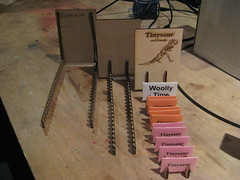I’m helping my friend Sara at the Squidfire Holiday Market in Baltimore, Maryland on Sunday. She suggested I bring some Tinysaurs, and so I made a display to neatly hold the Tinysaur kits.
I generated the pattern with a python script I wrote, using the sdxf library.
If you’d like to make your own, the DXF files are up on Thingiverse, or you can grab the python scripts and make one to your own dimensions. I cut it on the laser, but there’s no reason it couldn’t be cut on a scroll saw.
Here you can see my first attempt, second attempt, and final. The first two were in cardboard, fantastic for prototyping.
Once all this craft show stuff is over I will probably make a few available in my Etsy shop in case folks who do craft shows are interested in one.

